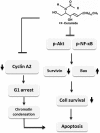The antiproliferative effect of C2-ceramide on lung cancer cells through apoptosis by inhibiting Akt and NFκB
- PMID: 24393431
- PMCID: PMC3893380
- DOI: 10.1186/1475-2867-14-1
The antiproliferative effect of C2-ceramide on lung cancer cells through apoptosis by inhibiting Akt and NFκB
Abstract
The anticancer effects of ceramide have been reported in many types of cancers but less in lung cancer. In this study, we used C2-ceramide to further investigate its possible anticancer effects and mechanisms on non-small cell lung cancer (NSCLC) H1299 cells. The result of cell proliferation in terms of trypan blue assay showed high dose of C2-ceramide inhibited cell survival after 24 h treatment. The flow cytometry-based assays indicated the effect of apoptosis, chromatin condensation, and G1 arrest in terms of Annexin V/propidium iodide (PI), DAPI, and PI stainings, respectively. Moreover, the decreased protein level of p-Akt, p-NFκB, survivin and cyclin A2 were detected by Western blot assay. Taken together, these results indicated the antiproliferative effect of C2-ceramide is majorly responsible for cell apoptosis in lung cancer H1299 cells.
Figures






Similar articles
-
Synergistic anticancer effect of combined use of Trichosanthes kirilowii with cisplatin and pemetrexed enhances apoptosis of H1299 non-small-cell lung cancer cells via modulation of ErbB3.Phytomedicine. 2020 Jan;66:153109. doi: 10.1016/j.phymed.2019.153109. Epub 2019 Oct 23. Phytomedicine. 2020. PMID: 31790894
-
Synergistic Anticancer Activity of Combined Use of Caffeic Acid with Paclitaxel Enhances Apoptosis of Non-Small-Cell Lung Cancer H1299 Cells in Vivo and in Vitro.Cell Physiol Biochem. 2018;48(4):1433-1442. doi: 10.1159/000492253. Epub 2018 Jul 31. Cell Physiol Biochem. 2018. PMID: 30064123
-
Lappaconitine sulfate induces apoptosis and G0/G1 phase cell cycle arrest by PI3K/AKT signaling pathway in human non-small cell lung cancer A549 cells.Acta Histochem. 2020 Jul;122(5):151557. doi: 10.1016/j.acthis.2020.151557. Epub 2020 Jun 6. Acta Histochem. 2020. PMID: 32622431
-
Antitumor effects of flavokawain-B flavonoid in gemcitabine-resistant lung cancer cells are mediated via mitochondrial-mediated apoptosis, ROS production, cell migration and cell invasion inhibition and blocking of PI3K/AKT Signaling pathway.J BUON. 2020 Jan-Feb;25(1):262-267. J BUON. 2020. PMID: 32277640
-
Herbal extract of Artemisia maritima induces selective anti-tumor effects in three human lung carcinoma cells (H1299, NCI-H1437, PC-14) through activating apoptosis-related proteins, G2/M cell cycle arrest and suppression of cell migration.J BUON. 2020 Mar-Apr;25(2):869-874. J BUON. 2020. PMID: 32521880
Cited by
-
Sphingolipid Metabolism and Signaling in Lung Cancer: A Potential Therapeutic Target.J Oncol. 2022 Jun 28;2022:9099612. doi: 10.1155/2022/9099612. eCollection 2022. J Oncol. 2022. PMID: 35799611 Free PMC article. Review.
-
Effects of Voltage and Treatment Time of Pulsed Electric Field on Electroporation in Rhizoctonia solani.Curr Microbiol. 2024 Jan 10;81(2):58. doi: 10.1007/s00284-023-03564-x. Curr Microbiol. 2024. PMID: 38196012
-
Zebrafish in Lung Cancer Research.Cancers (Basel). 2023 Sep 26;15(19):4721. doi: 10.3390/cancers15194721. Cancers (Basel). 2023. PMID: 37835415 Free PMC article. Review.
-
Pulsed electromagnetic fields: promising treatment for osteoporosis.Osteoporos Int. 2019 Feb;30(2):267-276. doi: 10.1007/s00198-018-04822-6. Epub 2019 Jan 2. Osteoporos Int. 2019. PMID: 30603841 Review.
-
The Expression of Non B Cell-Derived Immunoglobulins.Adv Exp Med Biol. 2024;1445:11-36. doi: 10.1007/978-981-97-0511-5_2. Adv Exp Med Biol. 2024. PMID: 38967747 Review.
References
-
- Travis WD, Brambilla E, Noguchi M, Nicholson AG, Geisinger K, Yatabe Y, Powell CA, Beer D, Riely G, Garg K. et al.International association for the study of lung cancer/American thoracic society/European respiratory society: international multidisciplinary classification of lung adenocarcinoma: executive summary. Proceedings of the American Thoracic Society. 2011;8(5):381–385. doi: 10.1513/pats.201107-042ST. - DOI - PubMed
-
- Shrivastav A, Murphy L. Interactions of PI3K/Akt/mTOR and estrogen receptor signaling in breast cancer. Breast Cancer Management. 2012;1(3):235–249. doi: 10.2217/bmt.12.37. - DOI
LinkOut - more resources
Full Text Sources
Other Literature Sources
Research Materials
Miscellaneous

